Twice-cooked pork (回锅肉) is one dish that I regularly order in Chinese restaurants. After much procrastination, I finally decided to make it at home.
Twice cooked pork is a famous Szechuan food that requires cooking twice. First, the pork is simmered in water, followed by pan-frying, and enrobed in a glossy thick gorgeous sauce made with a combination of chili bean paste and other unique Szechuan seasonings.
The result is a cuisine with strong savory flavor and slightly spicy, which is the hallmark of Szechuan food. It is an exciting flavor that you may have never experienced before, a gastronomical experience that left you full but still wanting more.
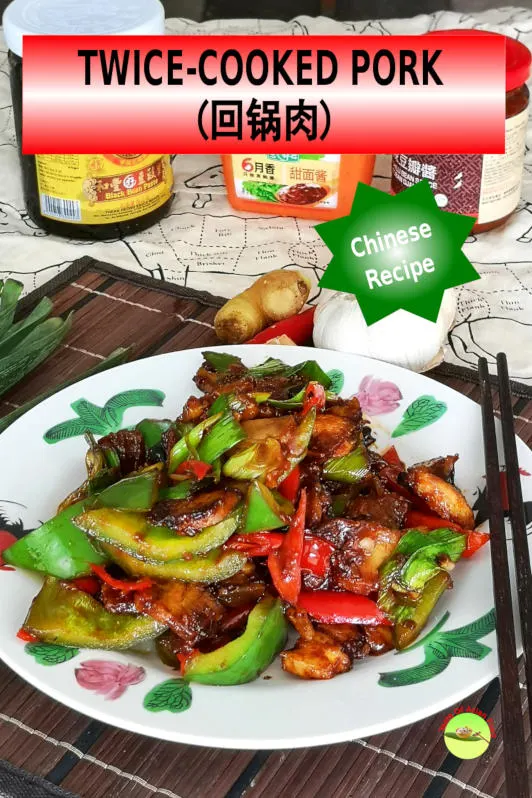
Twice cooked pork is also called double-cooked pork, hui guo rou or 回锅肉. The main reason to cook twice, i.e., simmer the pork and followed by pan-frying (or deep-frying), is to eliminate the undesirable porky smell.
Some fresh vegetables are usually included to balance the savory flavor. Garlic sprouts (蒜苗) are the most commonly used vegetable, but leek, scallions, and bell pepper are also popular.
This article explains how to prepare twice-cooked pork in detail.
Note: This post may contain affiliate links. Please read my privacy policy for more info. I may receive commissions for purchases made through links in this post. As an Amazon Associate, I earn from qualifying purchases.
1. Simmer the pork
Pork belly is the choice of cut to make twice-cooked pork since it has a distinct layer of fat from lean meat. The fatty pork will render the oil during pan-frying, used to flavor the vegetables. The pork will become crispy after frying, which is the characteristic of twice-cooked pork.
The first step is to simmer the pork belly until it is nearly cooked. You should season the water with scallion, ginger, and some peppercorns.
Here are the steps:
- Place the pork in cold water sufficient to submerge the pork.
- Add the ginger, scallions, and peppercorns.
- Bring it to a boil and simmer for about 15 to 20 minutes, or until the pork is nearly cooked. You can test the doneness by inserting a chopstick into the slab of pork. It is ready if you can poke the chopstick into the meat easily and hold it steady.
- Place the pork on kitchen paper towels to absorb as much water as possible. This step is vital because the pork will splatter in the pan during pan-frying if there is too much water in it.
- Let the pork cool down until it is manageable. Cut the pork into thin slices about the thickness of a coin. The pork is now ready for pan-frying.
2. Get ready all the unique seasonings
You need to use doubanjiang (chili bean paste), sweet bean paste, and black bean paste if you want to stay true to the authentic Sichuan flavor.
Let’s take a look at these ingredients briefly.
Chili bean paste (Doubanjiang / 豆瓣酱) is primarily made with fermented broad beans. There isn’t any substitute for it, but fortunately, it is widely available in Asian grocery stores and online from Amazon. It is commonly used in other Chinese cuisines, especially Szechuan cuisines, such as Mapo tofu and Ants Climbing a Tree.
Sweet bean paste (甜面酱, tian mian jiang, sweet bean sauce) is less common outside Asia, but similarly, it should be available at Asian grocery stores and online. If it is unavailable, you can reduce the sugar in the recipe and substitute it with hoisin sauce.
Black bean paste (douchi, black bean sauce, 豆豉) has an intense savory flavor. It is available in a paste, which is ready to use. This bean paste is the fermented version and should not substitute with fresh black beans, which tastes entirely different. You should be able to get it from most Asian markets. I do not use soy sauce as the bean paste is provided sufficient soy flavor for this dish.
Some recipes also include broad bean paste (doubanjiang , 豆瓣酱) which is common in Sichuan cuisines. I omit it as the above seasonings are sufficient to flavor the meat.
That is no need to use salt in this recipe because all these seasoning ingredients are salty.
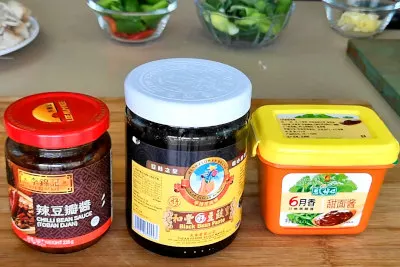
3. Prepare all the vegetables and aromatics
Coarsely chop two tablespoons of garlic and ginger. We will use these aromatics to saute the seasonings.
You also need some vegetables to stir fry with the pork. The most common vegetable is garlic sprouts (蒜苗). However, it may not be readily available outside Asia, and therefore you can use leek, scallions (spring onion), red chilies, red bell peppers, chili peppers as alternatives.
Cut the garlic sprouts or leek into 5 cm sections and 3 to 4 cm squares for the red chilies and bell peppers.
4. Pan-fried or deep-fried the pork slices
Heat some oil in a pan. You can either use a pan or a wok to pan-fry the pork since it does not require very high heat. The cooking oil required should be minimal since more oil will render from the fat during pan-frying.
The pork belly slices will become crispy if you slice them thinly. I pan-fried the pork slices, single layer, over medium heat for about 1 to 2 minutes on each side, until the pork turned brown. It will dry and tough if you fry the pork for too long since the pork slices are thin. Remove the pork slices, and leave the oil in the pan.
Alternatively, deep-fry pork slices in hot oil. However, I prefer pan-fried pork because less oil is required.
5. Stir-fry the pork with the vegetables
Now it comes to the final step of the cooking process. Once you have all the ingredients pre-portioned, you are ready to go.
Here are the steps:
- Saute the chopped ginger and garlic with the oil rendered from the pork. Saute over low heat to avoid the garlic from burning. Once you smell the aroma rising from the pan, add the chili bean paste, sweet bean paste, black bean, and some sugar.
- Keep the heat low so that you have time to add all the seasonings without concerned about burning the garlic. You can also include some rice wine or dry sherry for additional flavor. If you like it spicier, add a teaspoon or two of the Szechuan chili oil.
- Combine all the seasonings and wait until the oil starts separating from the paste.
- Now return the pork to the pan for the second time. Combine the meat with the seasonings and increase the heat slowly.
- Add all the vegetables into the pan and turn up the heat. Stir-fry over high heat for half a minute, or until the vegetables are no longer look raw. The time required depends very much on the quantity of the ingredients and the power of your stove.
- Once it is done, remove from heat immediately to avoid the vegetable from continuing cooking by the residue heat of the pan.
Twice cooked pork is best to serve with steamed rice or buns.
The name of this Szechuan dish is derived from this step. You can immediately understand why if you know the meaning of the Chinese name of this dish. It is called 回锅肉 in Chinese. The first character (回) means to return; the second character (锅) means the pan; the last character (肉) means the meat. Therefore these characters can be translated directly as “return pan meat.”
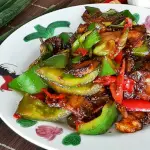
Twice-cooked pork
Twice-cooked pork is Szechuan style pork, which requires cooking twice - first simmer in water, followed by pan-frying and enrobed in a glossy thick gorgeous sauce made with a combination of chili bean paste and other unique Szechuan seasonings.
Ingredients
For the pork: (A)
- 400g pork belly (weight after purchase, cut into large chunks)
- 2 stalks scallions, cut into 5cm sections
- 3 slices ginger
- 1/4 tsp Szechuan peppercorns (Optional)
For the seasonings: (B)
- 2 tbsp chili bean paste
- 1 tbsp black bean
- 2 tbsp Chinese wine (Optional)
- 2 tsp sweet bean paste
- 1 tsp sugar
Aromatics: (C)
- 1 tbsp cooking oil
- 2 tsp garlic, coarsely chopped
- 2 tsp ginger, coarsely chopped
Vegetables: (D)
- 2 stalks of leek
- 1 small green bell pepper
- 2 red chilies
Instructions
- Place all the ingredients in A into a pot.
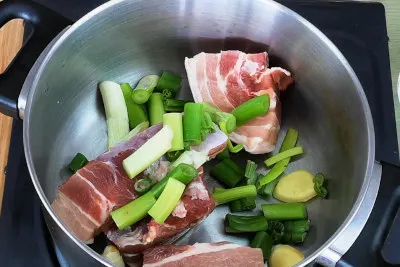
- Add sufficient water to submerge the pork. Bring the water to a boil.
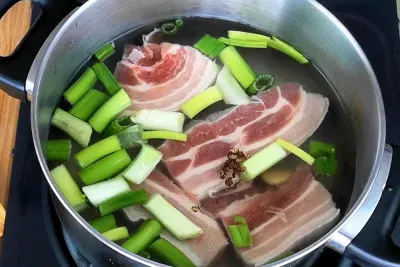
- Simmer for 15 minutes or until the pork is nearly fully cooked.
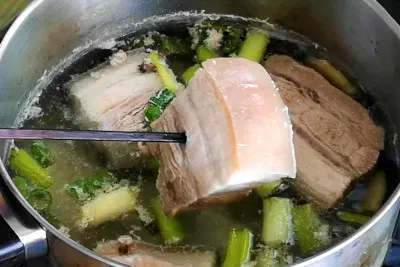
- Drained. Dry the pork with kitchen paper towels.
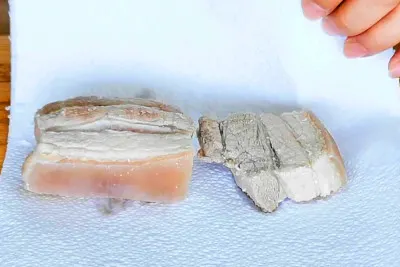
- Slice the pork into thin slices.
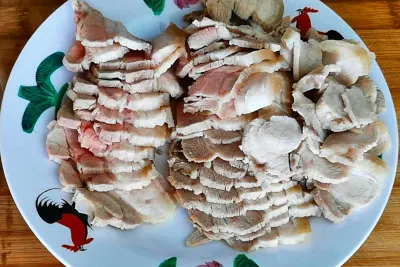
- Pan-fried the pork in a pan until both sides turn slightly brown.
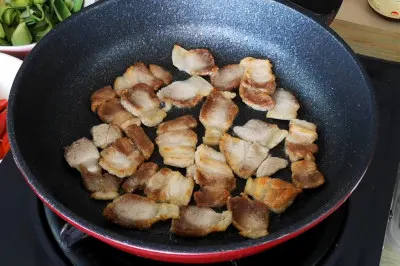
- Remove and leave the oil rendered in the pan. Saute the garlic and ginger until aromatic.
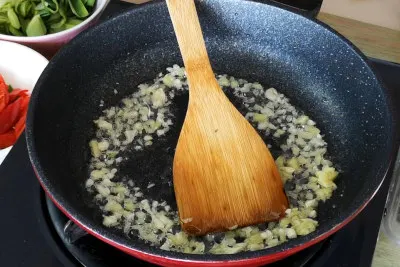
- Add seasonings B. Return the pork to the pan.
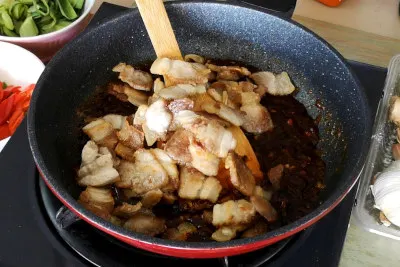
- Add the vegetable in D. Stir-fry over high heat for half a minute.
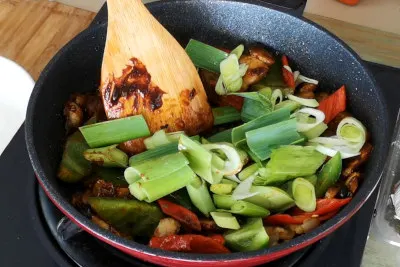
- Dish out and serve.
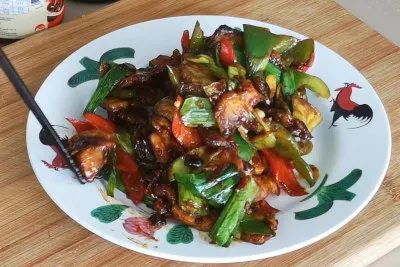
Recommended Products
As an Amazon Associate and member of other affiliate programs, I earn from qualifying purchases.
Nutrition Information:
Yield: 2 Serving Size: 1Amount Per Serving: Calories: 845Total Fat: 51gSaturated Fat: 16gTrans Fat: 0gUnsaturated Fat: 33gCholesterol: 168mgSodium: 343mgCarbohydrates: 43gFiber: 6gSugar: 13gProtein: 52g
This data was provided and calculated by Nutritionix on 3/6/2020

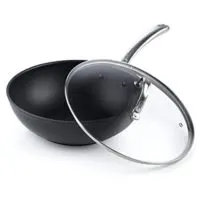

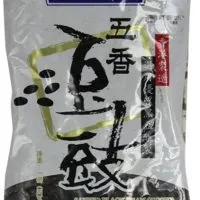

Jun
Saturday 11th of April 2020
do you have a recipe for eggplant with shrimp paste which I tried once I was in HK?
KP Kwan
Sunday 12th of April 2020
Hi Jun, I do not have that recipe, but it is an interesting one that I can try to make it. Hopefully, it will turn out great and upload the recipe, if successful :)
KP Kwan
Elsa Lock
Saturday 28th of March 2020
Very fragant!!! Done, tastes delicious. Thanks !!!
KP Kwan
Saturday 28th of March 2020
You are welcome Elsa :)
Robert Taylor
Saturday 7th of March 2020
I just read the article and cannot wait to try it. I have enjoyed many of your dishes. I cannot always get the items you use but I come close so I can only imagine what the real thing would taste like. Thanks for your web site.
KP Kwan
Saturday 7th of March 2020
Hi Robert, Thanks for trying out the recipe. Fully understand some specific items may not be readily available. You may want to improvise the recipe, although it may not be authentic. But I think it is ok as long as it is delicious. KP Kwan
Barbarainnc
Friday 6th of March 2020
Looks yummy. Found you while looking for General Tso's recipe. Thanks for sharing your recipes.
KP Kwan
Saturday 7th of March 2020
Thank you for trying, and I hope you will like it. You may also want to try the General Tso's chicken and General Tso's tofu on this blog. Cheers! KP Kwan
KP Kwan
Friday 6th of March 2020
Hi, this is KP Kwan. I am happy to see you in this comment area, as you have read through my recipe. I am pleased to reply to any questions and comments as soon as possible.
Mick
Saturday 4th of December 2021
@KP Kwan,
Cut the garlic sprouts or leak (Leek) into 5 cm sections. For the red chilies and bell peppers, cut them into 3 to 4 cm squares.